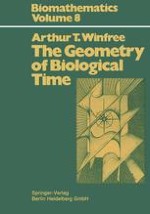1980 | OriginalPaper | Chapter
The Aggregation of Slime Mold Amoebae
Author : Arthur T. Winfree
Published in: The Geometry of Biological Time
Publisher: Springer Berlin Heidelberg
Included in: Professional Book Archive
Activate our intelligent search to find suitable subject content or patents.
Select sections of text to find matching patents with Artificial Intelligence. powered by
Select sections of text to find additional relevant content using AI-assisted search. powered by
Two kinds of slime mold play central roles in this book. Later on we will meet the “true” slime mold (Myxomycetes), an acellular jelly remarkable for the regularity and synchrony of mitosis in its many nuclei. Topologically, the true slime mold is one single monstrous cell. But in the present chapter, our concern is with the cellular slime molds (Acrasiales), the best studied of which is Dictyostelium discoideum (Bonner, 1967; Gerisch, 1968). This creature is more conventional in its cellular structure but is equally astonishing topologically in that its cells wander independently, like the individual workers of an ant colony. Like the ant hive, Dictyostelium is a “superorganism”, a genetically homogeneous being composed of autonomous individuals, nevertheless organized altruistically for the collective good. The life cycle runs as follows.
